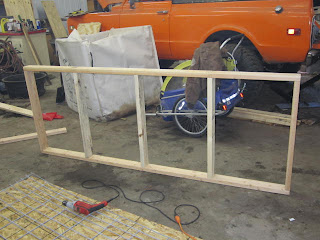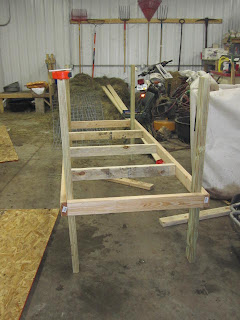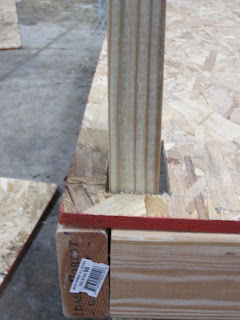Goat Feeding Area
It has taken us years of having goats to figure out exactly what we needed to have the perfect feeding area. Along with the goats we also have a llama so we had to make the feeders extra high so that he could not get over them and into the grain storage cans.
This feeder is the one closest to the garage door. As you can see Tom built the feeder into the wall so that the llama can not hop up and over the feeder. Or have the goats get over them either (don't think they could but you never know)
Here is the view you have when you first walk into the barn area from the shop. I can stuff the hay into the feeders with out tripping over the goats. Which was always one of my biggest problems, or having the goats push their way into the shop as I was walking in with my hands full of hay.
Here is the door into the goat area. We just took two pieces of left over hog panel and flipped them so that the smaller holes were both towards the bottom to keep the kids from getting stuck. Then we attached them with bunch of zip ties. Tom then made 3 wooden hinges to attach the gate to the wall. I wasn't sure about it but it has been working wonderful.
Here is my work counter above my grain storage cans. I have only used it two times since its been all finished but let me tell you having the bowls all spread out is a whole lot easier than having them on the ground. Much less of a mess and easier on my back.
Just a cute picture of our puppy Lucy meeting all the barn animals. A good way for her to meet them with out having to worry about the attack llama doing his job. Let me tell you he was watching her like a hawk though.
Heres a picture from the goat area, you can see where the two walls connect in the corner. One feeder on each wall so that the goats can all eat at the same time and have plenty of room.
I think we are going to put a mineral block holder on the open spot between the door and the corner. Its not good to waste space so we have to use all we have.
A nice view of the feeder that is connected to the wall. this one was 9 feet long and has a bar so that the kids can jump up and get the hay pulled out. Still might have to put a couple of cinder blocks down to make easier for the little kids.
Hay on the left grain storage on the right
More grain storage pictures but with the barn cat Bud
Final picture of the exit door to the outside. This allows me to sweep out the feeding area with out having to sweep into the goat area.
When we built the barn/shop this was why we had this service door installed right next to the garage door. (our building designer thought we were nuts having two doors 3 feet apart) Now I am so happy that we stuck to our guns and had the service door put in.



























